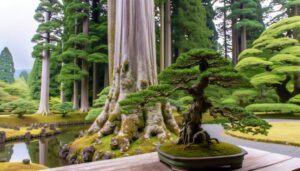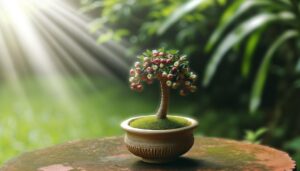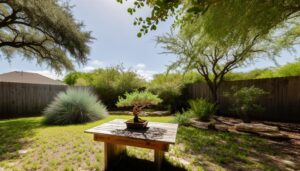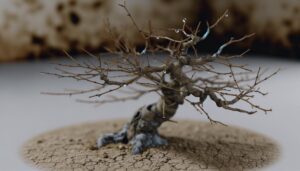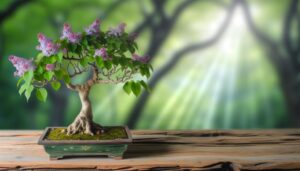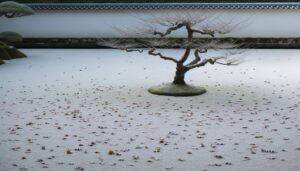Do Bonsai Trees Die in Winter Without Proper Care?
Bonsai trees can survive winter provided their specific care needs are met. Deciduous bonsai enter a dormant state and require minimal water and protection from extreme cold, while evergreen bonsai need consistent hydration and shelter from desiccation.
Cold-hardy species such as Juniperus and Pinus are well-adapted to low temperatures but must be protected from frost and wind. Indoor species, commonly tropical bonsai, need warm environments with regulated humidity.
Proper winter preparation involves mulching, wind protection, and careful watering. Thorough knowledge of a bonsai's biological and environmental needs is essential for winter survival.
Learn more about optimizing bonsai care throughout winter.
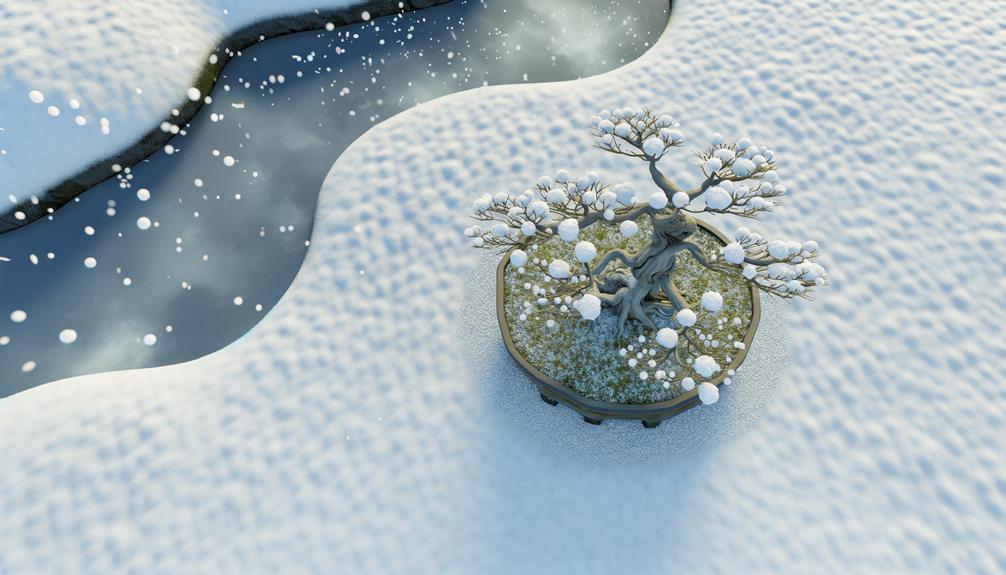
Key Takeaways
- Proper winter care, such as temperature regulation and correct watering, prevents bonsai tree mortality.
- Deciduous bonsai trees enter dormancy and need protection from extreme cold to survive winter.
- Evergreen bonsai trees require consistent hydration and moisture to avoid desiccation during winter.
- Cold-hardy species like Juniperus and Pinus thrive in low temperatures with appropriate frost protection.
- Indoor tropical bonsai trees need warm environments and regulated humidity to survive winter months.
Types of Bonsai Trees
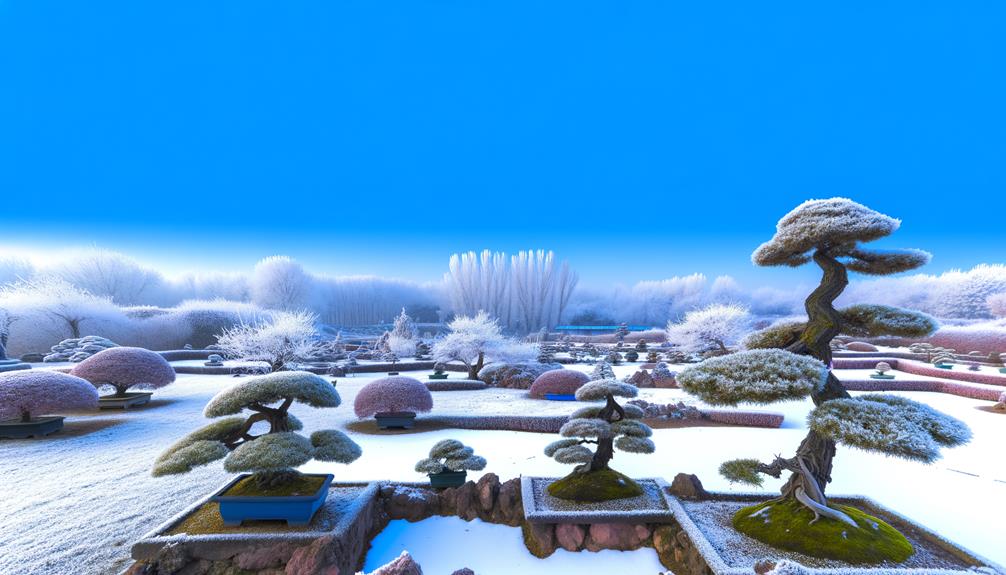
Among the various kinds of bonsai trees, deciduous, evergreen, and tropical species each possess distinct characteristics and requirements that influence their care and maintenance, particularly during winter months.
Deciduous bonsai, which shed their leaves, enter a dormant state requiring minimal water and protection from extreme cold.
Evergreen bonsai, retaining their foliage year-round, necessitate consistent hydration and shelter from freezing temperatures to avoid desiccation.
Tropical bonsai, native to warmer climates, demand stable, warm indoor environments and regulated humidity levels to thrive during colder periods.
Understanding these differences is crucial for bonsai enthusiasts, as improper winter care can lead to harmful effects, including root damage and ultimately, tree mortality.
Thorough knowledge of each type ensures optimal health and longevity.
Deciduous Vs. Evergreen
The distinction between deciduous and evergreen bonsai trees is critical for understanding their respective winter adaptations and care requirements.
Deciduous bonsai trees, which shed their leaves in response to reduced photoperiods and colder temperatures, necessitate specific protective measures to prevent root damage and desiccation.
Conversely, evergreen bonsai trees retain their foliage throughout the winter, requiring attention to prevent moisture loss and maintain metabolic functions during dormancy.
Leaf Shedding Patterns
Understanding the leaf shedding patterns of bonsai trees involves distinguishing between the behaviors of deciduous and evergreen species during winter.
Deciduous bonsai, such as Japanese Maple (Acer palmatum), undergo a natural process called abscission, where leaves change color and eventually fall off, conserving energy and water. This dormancy is essential for surviving colder temperatures.
In contrast, evergreen bonsai, such as Juniper (Juniperus spp.), retain their foliage year-round. These species have adapted to minimize water loss through needle-like leaves or waxy coatings, maintaining photosynthesis even in winter.
Recognizing these patterns is crucial for bonsai enthusiasts, as it guides appropriate seasonal care and safeguards the health of these miniature trees during the winter months.
Winter Care Needs
Proper winter care for bonsai trees necessitates distinct approaches for deciduous and evergreen species to guarantee their survival and health during colder months.
Deciduous bonsai enter dormancy, requiring protection from extreme cold while allowing for natural temperature fluctuations. Insulating materials like mulch or placement in cold frames can mitigate frost damage.
Conversely, evergreen bonsai maintain active metabolic processes and demand consistent, mild temperatures coupled with adequate light. Shielding evergreens from harsh winds and maintaining soil moisture are critical to prevent desiccation. Employing anti-desiccant sprays can further reduce water loss.
Both types benefit from reduced watering schedules, aligning with their lowered physiological activity, ensuring they remain hydrated without excess moisture that could lead to root rot.
Cold Hardy Bonsai
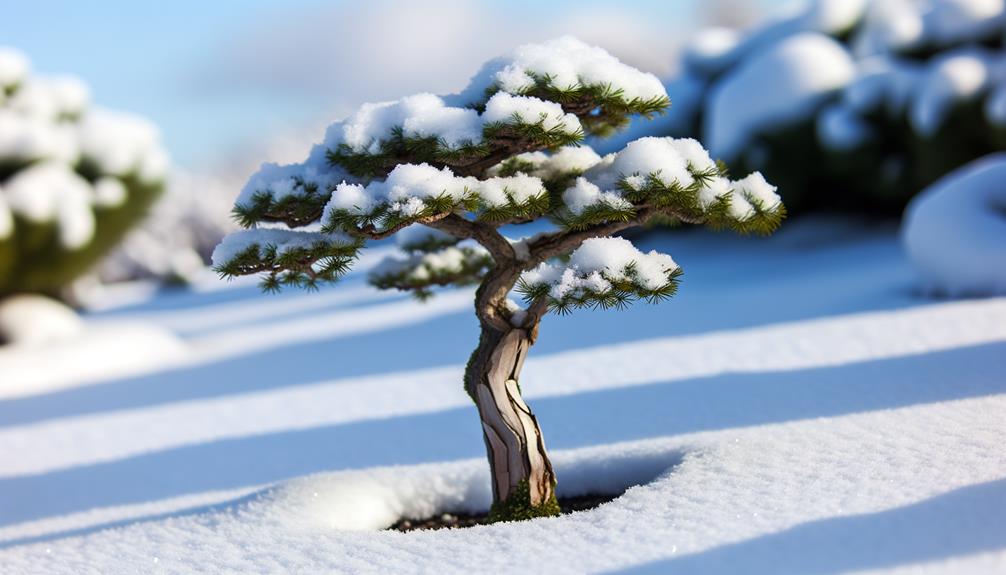
Cold-resistant bonsai species, such as Juniperus and Pinus, exhibit significant resilience to low temperatures, making them suitable candidates for outdoor cultivation in winter climates.
Successful winter care involves precise regulation of water intake, protection from excessive frost, and strategic placement to shield from harsh winds.
Understanding the specific biological needs and adaptive mechanisms of these species is essential for maintaining their health and aesthetic form throughout the winter season.
Winter Care Tips
Guaranteeing the health and strength of cold-resistant bonsai trees during winter requires meticulous attention to temperature regulation, watering practices, and protection from frost. Proper winter care enhances the resilience and vigor of these miniature trees.
Key considerations include:
- Temperature Regulation: Maintain temperatures between 20°F to 50°F to prevent root damage.
- Watering Practices: Water sparingly, making certain soil remains slightly moist but not waterlogged to avoid root rot.
- Protection from Frost: Use mulch or a cold frame to insulate roots and shield from extreme cold.
- Monitoring: Regularly inspect for signs of stress or disease, addressing issues promptly.
Following these guidelines secures bonsai trees remain robust throughout the winter season.
Suitable Bonsai Species
Selecting the appropriate species of bonsai trees that can withstand harsh winter conditions is fundamental for ensuring their long-term survival and growth. Cold-hardy species are specifically adapted to endure low temperatures and frost, minimizing the risk of winter die-off. Key factors include native climate adaptability and intrinsic cold resistance. For enthusiasts, the following table lists some ideal cold-hardy bonsai species:
| Species | Scientific Name | Key Features |
|---|---|---|
| Japanese Maple | Acer palmatum | Deciduous, vibrant autumn foliage |
| Boxwood | Buxus sempervirens | Evergreen, dense foliage |
| Chinese Elm | Ulmus parvifolia | Semi-deciduous, resilient bark |
These species, with their inherent winter resilience, are excellent choices for bonsai cultivation in colder climates.
Indoor Vs. Outdoor
When deciding whether to keep a bonsai tree indoors or outdoors during winter, it is essential to take into account the species-specific tolerance levels to cold temperatures and varying humidity conditions. Outdoor bonsai species typically include temperate trees that require a period of dormancy to thrive, such as maples and pines.
Conversely, indoor bonsai species, like tropical and subtropical varieties, are less tolerant of freezing temperatures and need a controlled environment.
- Temperature Tolerance: Understanding the minimum temperature your bonsai can endure is critical.
- Humidity Levels: Indoor environments often lack the humidity necessary for some species.
- Light Requirements: Different species have varying light needs that must be met.
- Dormancy Needs: Outdoor species often require a winter dormancy period to maintain health.
Preparing for Winter
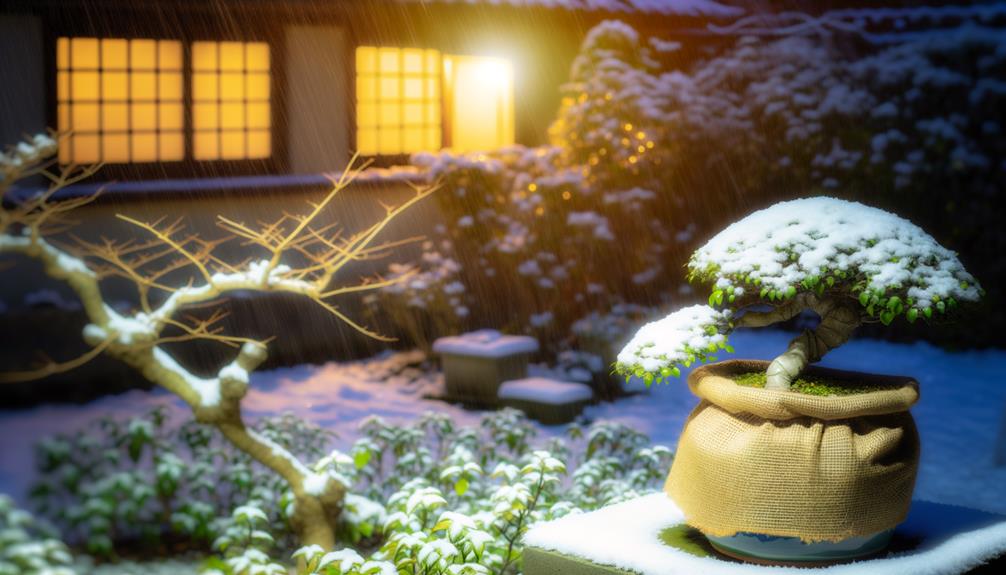
Proper preparation for winter involves a detailed assessment of the specific needs of your bonsai tree species. This includes their temperature tolerance, watering requirements, and protective measures against frost. It is vital to recognize that different species have varying cold hardiness levels.
Deciduous bonsai, for instance, may require minimal protection, while tropical varieties necessitate more controlled environments. Implementing mulching techniques can insulate roots, mitigating temperature fluctuations. Additionally, shielding bonsai from harsh winds using windbreaks or cold frames can prevent desiccation and frost damage.
Ensuring that the bonsai substrate remains well-draining is essential to avoid root rot during colder months. These meticulous preparations enable bonsai trees to endure winter stress, preserving their health and longevity.
Watering in Winter
During the winter months, it is important to adjust the watering schedule of bonsai trees to prevent root rot and other moisture-related issues. Reduced watering frequency is vital due to the decreased metabolic activity of the plants, requiring monitoring of soil moisture levels to ensure ideal hydration.
Additionally, the care needs for indoor versus outdoor bonsai trees differ significantly, requiring customized approaches to maintain plant health during colder temperatures.
Reduced Watering Frequency
As temperatures drop and bonsai trees enter their dormant phase, the plant's metabolic processes slow considerably, necessitating a decrease in watering frequency to prevent root rot and other moisture-related issues.
During winter, the water needs of bonsai trees diminish, making it essential to adjust your watering schedule accordingly. Overwatering during this period can lead to detrimental consequences such as fungal growth and root suffocation.
Key considerations for reduced watering frequency include:
- Observation: Regularly inspect the soil to gauge moisture levels before watering.
- Drainage: Guarantee proper pot drainage to avoid water accumulation.
- Species-specific Needs: Understand the specific requirements of your bonsai variety.
- Environmental Factors: Take into account indoor humidity and ambient temperature variations.
Adhering to these principles promotes healthier bonsai during winter dormancy.
Soil Moisture Levels
Monitoring soil moisture levels becomes particularly important during winter, as bonsai trees require a delicate balance between hydration and dryness to maintain peak health. Winter dormancy reduces their metabolic rate, necessitating less frequent watering. However, the substrate must never dry out completely, as this could trigger root desiccation and subsequent tree decline.
Conversely, overly saturated soil can lead to root rot due to diminished oxygen availability. Employing a moisture meter or manual inspection—by inserting a finger an inch into the soil—can provide accurate moisture status. Adjusting watering practices to environmental variables such as indoor heating or outdoor frost is essential.
Ensuring ideal soil moisture levels supports the bonsai's resilience during the colder months.
Indoor Vs. Outdoor Care
Differentiating between indoor and outdoor care for bonsai trees during winter requires a nuanced understanding of their distinct watering requirements based on environmental conditions. For indoor bonsai, lower light levels and stable temperatures reduce evaporation rates, leading to less frequent watering.
Conversely, outdoor bonsai, exposed to fluctuating temperatures, may need more attentive monitoring to prevent root desiccation or freezing. Key points for effective winter watering include:
- Frequency: Indoor bonsai need less water; outdoor bonsai may need careful monitoring.
- Water temperature: Use lukewarm water to avoid shocking the roots.
- Humidity: Indoor environments often require additional moisture.
- Soil drainage: Ensure both indoor and outdoor bonsai have well-draining soil to prevent waterlogging.
Understanding these differences promotes the best health for bonsai trees through winter.
Frost Protection
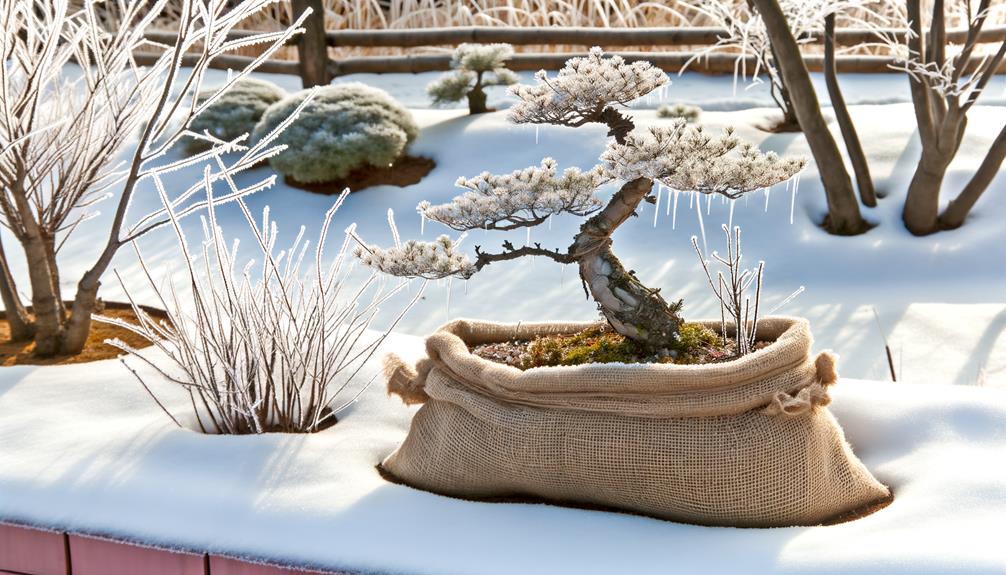
Protecting bonsai trees from frost damage is vital to guaranteeing their survival and health during the winter months. The cellular structure of bonsai trees is particularly susceptible to freezing temperatures, which can lead to cell rupture and subsequent tissue necrosis.
To mitigate frost damage, it is crucial to implement protective measures such as mulching the soil surface, using frost cloths, and situating bonsai in sheltered locations, like unheated greenhouses or cold frames. These methods create microclimates that buffer against extreme temperature fluctuations.
Additionally, elevating the bonsai off the ground prevents root exposure to freezing, while proper hydration ensures cellular resilience. Employing these detailed frost protection strategies is essential for maintaining the physiological integrity and longevity of bonsai trees during cold periods.
Winter Dormancy
Understanding the process of winter dormancy in bonsai trees is fundamental, as this period of metabolic slowdown and growth cessation is a natural response to the colder temperatures and reduced daylight hours characteristic of winter. Dormancy is an adaptive mechanism that enables bonsai trees to conserve energy and protect essential tissues from winter stress.
Key physiological changes include:
- Reduced Photosynthesis: Chlorophyll production diminishes, leading to decreased photosynthetic activity.
- Carbohydrate Storage: Trees store carbohydrates in roots and trunks to use as energy during dormancy.
- Decreased Water Uptake: Root activity slows, reducing water absorption to prevent cellular damage from freezing.
- Hormonal Shifts: Increased levels of abscisic acid inhibit growth and promote dormancy.
Understanding these adaptations ensures proper care and enhances bonsai tree resilience during winter dormancy.
Common Winter Issues
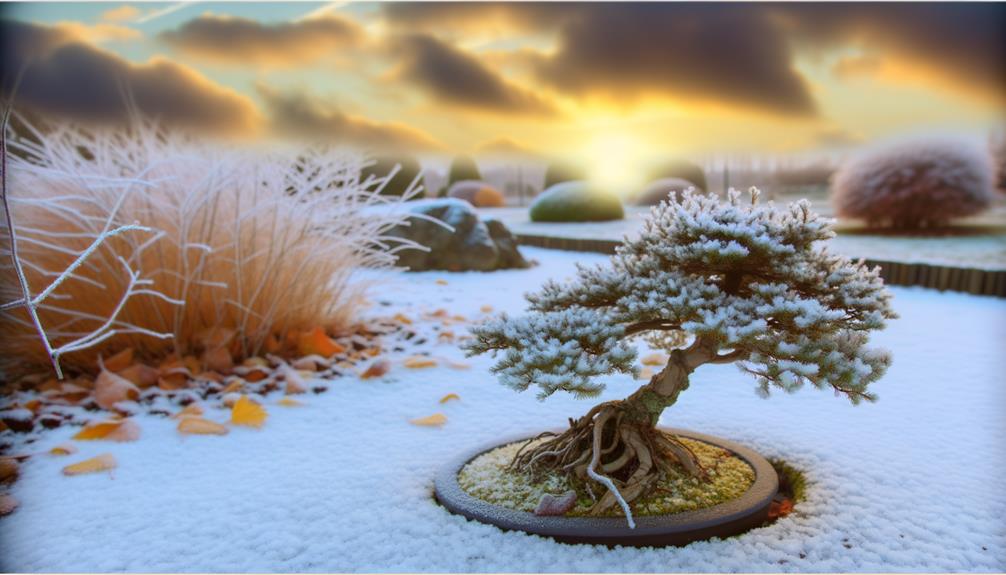
Winter can present several challenges for bonsai trees, including frost damage, dehydration, and pest infestations, all of which require careful management to maintain tree health. Frost can cause cellular damage, leading to dieback or death. Dehydration occurs as water uptake diminishes due to frozen soil, stressing the plant. Additionally, pests such as spider mites may exploit weakened trees, exacerbating winter stress.
| Issue | Emotional Impact |
|---|---|
| Frost Damage | Heartbreaking |
| Dehydration | Worrisome |
| Pest Infestations | Frustrating |
Preventive measures, including proper insulation, controlled watering, and regular inspections, are imperative. Understanding these issues promotes proactive care, ensuring bonsai trees not only survive but thrive through winter's rigor.
Myths About Winter Care
Despite the challenges posed by winter, several persistent myths about bonsai care during this season can lead to misconceptions and improper practices. Understanding these myths is vital for ensuring the health and longevity of your bonsai. For instance, it is erroneous to believe that all bonsai trees should be kept indoors during winter. Many species actually benefit from cold dormancy.
Common myths include:
- All bonsai trees need to be kept indoors: Only tropical and subtropical species require indoor protection.
- Watering should be stopped entirely: Reduced, but consistent, watering is essential.
- Fertilization is unnecessary: Some light fertilization can support root health.
- No protection from frost is needed: Frost can damage roots, requiring protective measures.
Debunking these myths promotes proper winter care.
Conclusion
As winter's icy tendrils envelop the landscape, bonsai trees, whether deciduous or evergreen, navigate this frost-laden season through intricate survival mechanisms. Cold-resistant species endure the chill, while others need careful indoor care. Essential preparations, such as frost protection and understanding natural dormancy cycles, help alleviate common winter challenges. Dispelling myths surrounding winter care guarantees these miniature arboreal marvels continue to thrive.
Consequently, the dance between bonsai and winter is one of resilience and adaptation, a delicate balance of nature's rhythms.

